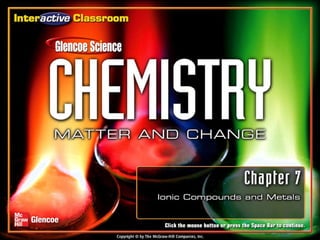Cmc chapter 07
•Transferir como PPT, PDF•
9 gostaram•4,480 visualizações
Denunciar
Compartilhar
Denunciar
Compartilhar

Recomendados
Recomendados
Mais conteúdo relacionado
Mais procurados
Mais procurados (20)
Chemistry - Chp 7 - Ionic and Metallic Bonding - PowerPoint

Chemistry - Chp 7 - Ionic and Metallic Bonding - PowerPoint
Types Of Chemical Bonds- Ionic Bond,Covalent Bonds,Coordinate Bonds, Basic In...

Types Of Chemical Bonds- Ionic Bond,Covalent Bonds,Coordinate Bonds, Basic In...
Destaque
Destaque (10)
The factors that affect the stability of complexes 

The factors that affect the stability of complexes
Semelhante a Cmc chapter 07
Semelhante a Cmc chapter 07 (20)
Conditions for Formation of Ionic and Covalent Bonds

Conditions for Formation of Ionic and Covalent Bonds
Chemical bonding xi , dr.mona srivastava , founder masterchemclasses

Chemical bonding xi , dr.mona srivastava , founder masterchemclasses
Mais de Jane Hamze
Mais de Jane Hamze (20)
Último
https://app.box.com/s/7hlvjxjalkrik7fb082xx3jk7xd7liz3TỔNG ÔN TẬP THI VÀO LỚP 10 MÔN TIẾNG ANH NĂM HỌC 2023 - 2024 CÓ ĐÁP ÁN (NGỮ Â...

TỔNG ÔN TẬP THI VÀO LỚP 10 MÔN TIẾNG ANH NĂM HỌC 2023 - 2024 CÓ ĐÁP ÁN (NGỮ Â...Nguyen Thanh Tu Collection
Último (20)
Mixin Classes in Odoo 17 How to Extend Models Using Mixin Classes

Mixin Classes in Odoo 17 How to Extend Models Using Mixin Classes
ICT Role in 21st Century Education & its Challenges.pptx

ICT Role in 21st Century Education & its Challenges.pptx
Unit-IV; Professional Sales Representative (PSR).pptx

Unit-IV; Professional Sales Representative (PSR).pptx
Jual Obat Aborsi Hongkong ( Asli No.1 ) 085657271886 Obat Penggugur Kandungan...

Jual Obat Aborsi Hongkong ( Asli No.1 ) 085657271886 Obat Penggugur Kandungan...
TỔNG ÔN TẬP THI VÀO LỚP 10 MÔN TIẾNG ANH NĂM HỌC 2023 - 2024 CÓ ĐÁP ÁN (NGỮ Â...

TỔNG ÔN TẬP THI VÀO LỚP 10 MÔN TIẾNG ANH NĂM HỌC 2023 - 2024 CÓ ĐÁP ÁN (NGỮ Â...
On National Teacher Day, meet the 2024-25 Kenan Fellows

On National Teacher Day, meet the 2024-25 Kenan Fellows
This PowerPoint helps students to consider the concept of infinity.

This PowerPoint helps students to consider the concept of infinity.
Basic Civil Engineering first year Notes- Chapter 4 Building.pptx

Basic Civil Engineering first year Notes- Chapter 4 Building.pptx
Cmc chapter 07
- 2. Chapter Menu Ionic Compounds and Metals Section 7.1 Ion Formation Section 7.2 Ionic Bonds and Ionic Compounds Section 7.3 Names and Formulas for Ionic Compounds Section 7.4 Metallic Bonds and the Properties of Metals Exit Click a hyperlink or folder tab to view the corresponding slides.
- 13. End of Section 7-1
- 15. Section 7-2 Section 7.2 Ionic Bonds and Ionic Compounds (cont.) ionic bond ionic compound crystal lattice electrolyte lattice energy Oppositely charged ions attract each other, forming electrically neutral ionic compounds.
- 17. Section 7-2 Formation of an Ionic Bond (cont.)
- 29. End of Section 7-2
- 31. Section 7-3 Section 7.3 Names and Formulas for Ionic Compounds (cont.) formula unit monatomic ion oxidation number polyatomic ion oxyanion In written names and formulas for ionic compounds, the cation appears first, followed by the anion.
- 37. Section 7-3 Formulas for Ionic Compounds (cont.)
- 39. Section 7-3 Names for Ions and Ionic Compounds (cont.)
- 41. Section 7-3 Names for Ions and Ionic Compounds (cont.)
- 44. End of Section 7-3
- 46. Section 7-4 Section 7.4 Metallic Bonds and the Properties of Metals (cont.) electron sea model delocalized electron metallic bond alloy Metals form crystal lattices and can be modeled as cations surrounded by a “sea” of freely moving valence electrons.
- 54. Section 7-4 Metal Alloys (cont.)
- 58. End of Section 7-4
- 59. Resources Menu Chemistry Online Study Guide Chapter Assessment Standardized Test Practice Image Bank Concepts in Motion
- 76. IB Menu Click on an image to enlarge.
- 77. IB 1
- 78. IB 2
- 79. IB 3
- 80. IB 4
- 81. IB 5
- 82. IB 6
- 83. IB 7
- 84. IB 8
- 85. IB 9
- 86. IB 10
- 87. IB 11
- 88. IB 12
- 89. IB 13
- 90. IB 14
- 91. IB 15
- 92. IB 16
- 93. IB 17
- 94. IB 18
- 95. IB 19
- 96. IB 20
- 97. IB 21
- 98. IB 22
- 99. CIM Table 7.1 Electron-Dot Structure Table 7.4 Formation of Sodium Chloride
- 100. Help Click any of the background top tabs to display the respective folder. Within the Chapter Outline, clicking a section tab on the right side of the screen will bring you to the first slide in each respective section. Simple navigation buttons will allow you to progress to the next slide or the previous slide. The “Return” button will allow you to return to the slide that you were viewing when you clicked either the Resources or Help tab. The Chapter Resources Menu will allow you to access chapter specific resources from the Chapter Menu or any Chapter Outline slide. From within any feature, click the Resources tab to return to this slide. To exit the presentation, click the Exit button on the Chapter Menu slide or hit Escape [Esc] on your keyboards while viewing any Chapter Outline slide.
- 101. End of Custom Shows This slide is intentionally blank.